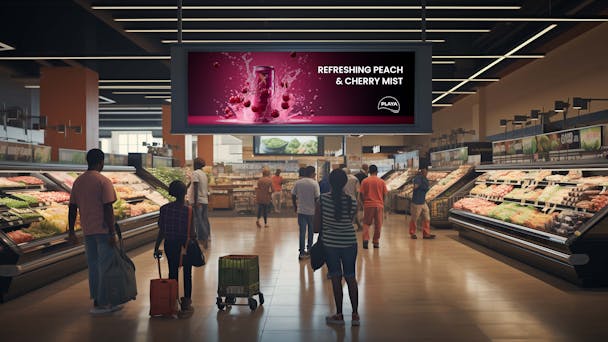Tech on the menu: The integration of DOOH in the food and beverage industry
For The Drum's Food & Drink content focus, the team at Hivestack by Perion explore the benefits of digital out of home's role in the sector, from geotargeting to interactive experiences.

The food and beverage (F&B) industry is one of the largest in the world and staying ahead of the competition requires innovative marketing strategies. The digitization of the industry has given brands a smarter way to connect with audiences in a contextually relevant way without breaking their budgets.
For example, Coca-Cola has doubled its investment in digital since 2019 and claims this transformation is making its portfolio of brands more relevant with today's customers.
Advertisement
And when it comes to reaching those customers with the most contextually relevant ad experience, one channel continues to come out on top, and that’s programmatic digital out of home (DOOH).
Learn the various ways in which F&B marketers can benefit from programmatic DOOH, enhancing brand visibility, engagement and ultimately, boosting sales.
Dynamic creative optimization (DCO)
Programmatic DOOH allows marketers to dynamically update content based on real-time data. In the food and beverage industry, this means tailoring advertisements to factors like weather, time of day, or even local events.
For instance, an advertisement for a refreshing beverage may be more effective during hot weather, or a promotion for a late-night snack could be displayed in the evening.
A prime example of this can be seen in leading European craft brewery and pub chain, BrewDog who used programmatic DOOH to drive brand awareness for their "Hazy Jane" beer by tapping into the “hazy summer sky” - an occasional weather phenomenon in the UK’s capital city, London, during the summer season. The campaign ran for two weeks on 10 iconic billboards and urban panels and delivered over a million impressions.
Competitor conquesting
Marketers can also use programmatic DOOH to target their competitor's audience with the intent of winning them over and driving them towards a location or product.
For example, one strategy could see a brand wanting to convert customers who have visited a competitors’ restaurant. By setting up proximity geotargeting around that location, they could activate specific DOOH boards with their campaign utilizing a promotion, or discount code.
Advertisement
For the North American hard seltzer brand, White Claw, targeting young adults between the ages of 19-34 in key locations where competitor drinks were likely to be on offer (such as at concert stadiums and on popular cottage country commuter routes was key to its strategy), drove a 3X lift in brand awareness the brand.
Geotargeting for hyper-local impact
Implementing targeting based on geographic locations in programmatic DOOH enables marketers to deliver highly localized and relevant content. Restaurants, cafes and food retailers can leverage this by promoting specific offers, menu items, or events to potential customers in close proximity. This hyper-local approach helps to connect with consumers at the right place and time, driving foot traffic and increasing brand loyalty.
Thailand’s leading F&B company, Bar. B.Q Plaza took this further by gamifying the experience for its customers. It wanted to improve its brand awareness by connecting with target audiences located around Bangkok's Mass Transit System (BTS) train stations. By scanning the QR code on digital panels, audiences were led to the 'Gashapon' game on their mobile phones where they were presented with the opportunity to redeem dining vouchers for Bar.B.Q Plaza restaurants.
84 unique versions of the campaign creative were activated successfully and delivered across all locations, which resulted in four million impressions.
Cross-channel integration
Integrating programmatic DOOH with other digital channels creates a cohesive and immersive brand experience. Syncing campaigns across social media and mobile apps ensures a consistent message, reinforcing brand recall. For instance, a restaurant promoting a new menu item on DOOH screens can simultaneously run a social media campaign with behind-the-scenes content, creating a multi-dimensional marketing approach.
Interactive experiences
Engagement is crucial in the food and beverage industry and programmatic DOOH provides opportunities for interactive experiences. Incorporating QR codes, or user-generated content encourages consumers to actively engage with the brand. For example, a beverage brand could engage with customers who have interacted with their ads on other channels, and vice versa, to reinforce the campaign’s message and drive outcomes.
Suggested newsletters for you
As technology continues to advance, embracing programmatic DOOH will be essential for staying ahead and creating memorable experiences that resonate with today's discerning F&B consumers.
Content by The Drum Network member:

Hivestack by Perion
Hivestack by Perion is the largest global, full stack, marketing technology company, powering the buy and sell side of programmatic digital out of home (DOOH) advertising....
Find out more
